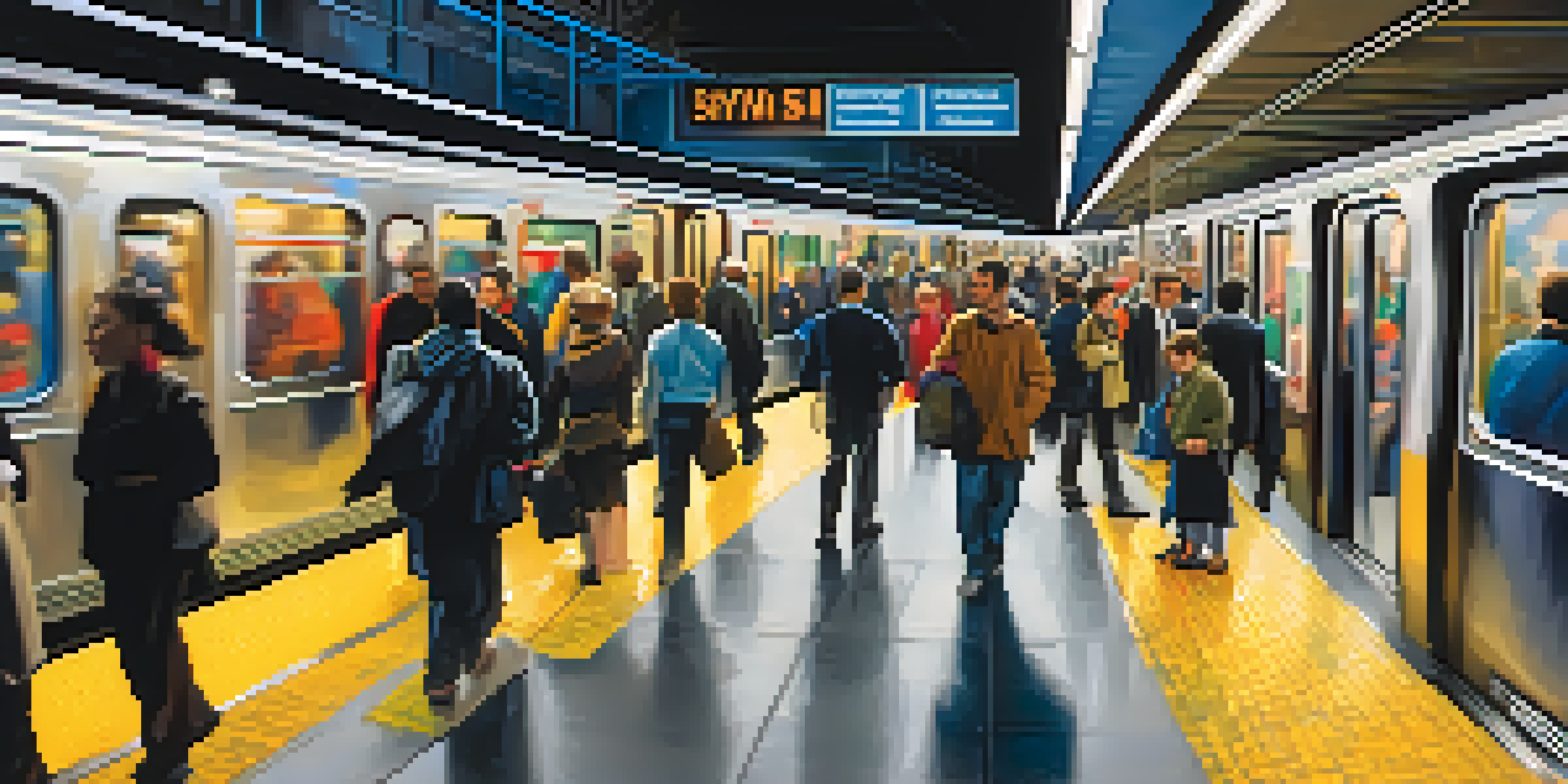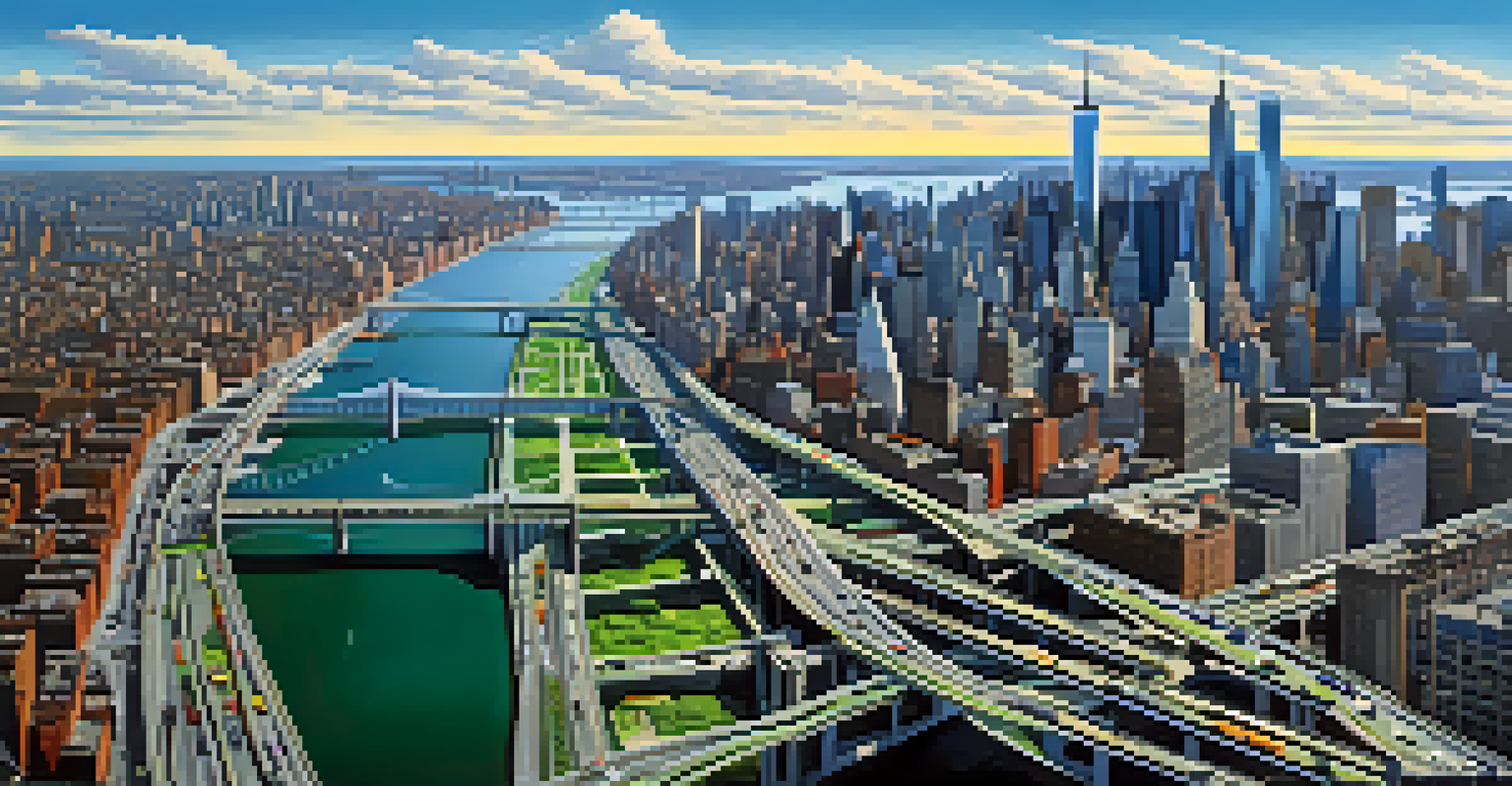The Economic Impact of Transportation in New York State

Transportation: The Backbone of New York's Economy
Transportation is often referred to as the backbone of any economy, and New York State is no exception. With its extensive network of roads, railways, and airports, transportation facilitates the movement of goods and people, driving economic activity. In fact, transportation contributes billions to the state's GDP, underlining its crucial role in fostering growth and innovation.
Transportation is the key to economic development and competitiveness.
The diverse modes of transportation available in New York offer unique advantages. For instance, New York City’s subway system not only eases daily commutes but also supports local businesses by increasing foot traffic. Similarly, freight transportation via rail and road keeps supply chains efficient, benefiting industries from agriculture to manufacturing.
As we look to the future, investment in transportation infrastructure remains vital. Upgrades and expansions can enhance connectivity and accessibility, ultimately attracting more businesses and creating jobs. This cycle of investment and growth showcases just how intertwined transportation is with New York's economic landscape.
Job Creation Through Transportation Development
One of the most significant economic impacts of transportation is job creation. The construction, operation, and maintenance of transportation systems generate countless jobs, ranging from engineers to transit workers. These jobs not only provide livelihoods but also stimulate local economies through increased spending.

Moreover, transportation projects often lead to secondary job creation. For example, when a new subway line is built, it opens up new areas for development, leading to construction jobs, retail establishments, and service industries. This domino effect amplifies the economic benefits of transportation investments.
Transportation Drives Economic Growth
New York's extensive transportation network is crucial for facilitating the movement of goods and people, significantly contributing to the state's GDP.
In New York, initiatives like the expansion of the Port Authority have proven instrumental in boosting employment rates. By enhancing the capacity for cargo and passenger movement, these developments have created thousands of jobs, underscoring the importance of strategic transportation planning.
Transportation and Trade: A Vital Connection
New York State's transportation infrastructure plays a critical role in facilitating trade, both domestically and internationally. The state's strategic location, coupled with its robust transportation network, makes it a key player in the global supply chain. This accessibility enables businesses to efficiently import and export goods, thereby expanding market reach.
The future of transportation is not just about moving people, but about connecting them to opportunities.
For instance, the presence of major airports and extensive rail systems allows for swift movement of perishable goods and essential products. This efficiency not only supports local businesses but also strengthens New York’s position as a hub for international commerce. The ability to connect with global markets is an asset that drives economic growth.
Furthermore, transportation investments enhance trade relationships with neighboring states and countries. Improved logistics and infrastructure lead to lower shipping costs and faster delivery times, making New York an attractive destination for businesses looking to thrive in a competitive market.
Environmental Considerations in Transportation Planning
As New York continues to grow, the environmental impact of transportation cannot be overlooked. Transportation is a significant contributor to greenhouse gas emissions, prompting the need for sustainable solutions. By prioritizing eco-friendly transportation options, such as public transit and cycling infrastructure, New York can reduce its carbon footprint.
Investments in green transportation not only benefit the environment but also stimulate economic growth. For example, the development of electric vehicle charging stations creates new business opportunities while encouraging the adoption of cleaner technologies. This transition helps to create a more sustainable economy.
Job Creation from Transport Projects
Investments in transportation infrastructure not only create direct jobs but also lead to secondary job growth in various sectors.
Moreover, promoting public transportation can lead to reduced traffic congestion, enhancing the quality of life for New Yorkers. The resulting decrease in air pollution and reliance on fossil fuels reflects a commitment to building a more sustainable future, addressing both economic and environmental challenges.
The Role of Technology in Modern Transportation
Technology is transforming the transportation landscape in New York, offering innovative solutions to age-old challenges. Smart traffic management systems, for instance, can optimize traffic flow and reduce congestion, leading to more efficient commutes. This integration of technology not only enhances user experience but also supports economic productivity.
Additionally, ride-sharing apps and electric scooters have emerged as alternatives to traditional transportation modes. These options provide greater flexibility and convenience for commuters, helping to alleviate the strain on public transit systems. As these technologies evolve, they create new business models and opportunities within the transportation sector.
Furthermore, advancements in autonomous vehicles promise to revolutionize transportation in New York. If successfully implemented, self-driving cars could reduce accidents and improve traffic efficiency, significantly impacting economic activity and urban planning. Embracing these technologies is essential for maintaining New York's competitive edge.
Challenges Facing New York's Transportation Infrastructure
Despite its strengths, New York's transportation infrastructure faces several challenges that could hinder economic growth. Aging infrastructure, coupled with underfunding, leads to delays and inefficiencies that impact both commuters and businesses. Addressing these issues is essential for sustaining the economic benefits that transportation provides.
Moreover, congestion remains a persistent problem, particularly in urban areas. The high volume of vehicles not only increases travel times but also contributes to pollution and economic losses. Strategies to mitigate congestion, such as congestion pricing and improved public transit options, must be prioritized to ensure a smooth flow of people and goods.
Sustainability is Key for Future Planning
Prioritizing sustainable transportation solutions is essential for reducing environmental impact while enhancing economic opportunities in New York.
Lastly, climate change poses a significant threat to transportation infrastructure. Extreme weather events can damage roads, bridges, and transit systems, leading to costly repairs and disruptions. Proactive planning and investment in resilient infrastructure are crucial to safeguarding New York's economy against these unpredictable challenges.
Future Trends in Transportation and Economic Growth
Looking ahead, several trends are likely to shape the future of transportation in New York and its economic impact. The shift towards sustainability will continue to drive investments in green transportation initiatives, promoting cleaner alternatives. This focus on sustainability not only benefits the environment but also enhances public health and well-being.
Additionally, the rise of remote work and changes in commuting patterns may influence transportation needs. As more people work from home, there could be decreased demand for traditional commuting options, prompting a reevaluation of transportation planning. Understanding these shifts is vital for adapting to a changing economic landscape.

Finally, the integration of data analytics and technology in transportation will pave the way for smarter urban planning. By leveraging data to understand travel patterns and optimize services, New York can create a transportation system that meets the evolving needs of its residents and businesses, fostering continued economic growth.